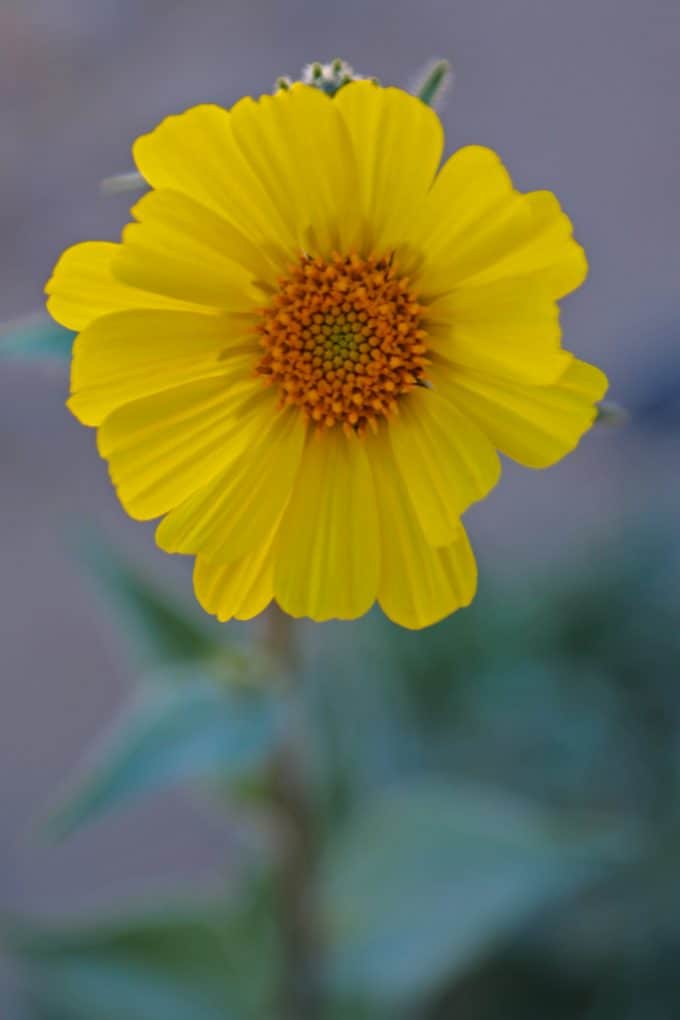Epic Guide to Death Valley National Park in California and Nevada. Everything you need to plan an amazing National Park vacation including lodging, camping, things to do, weather, and so much more.
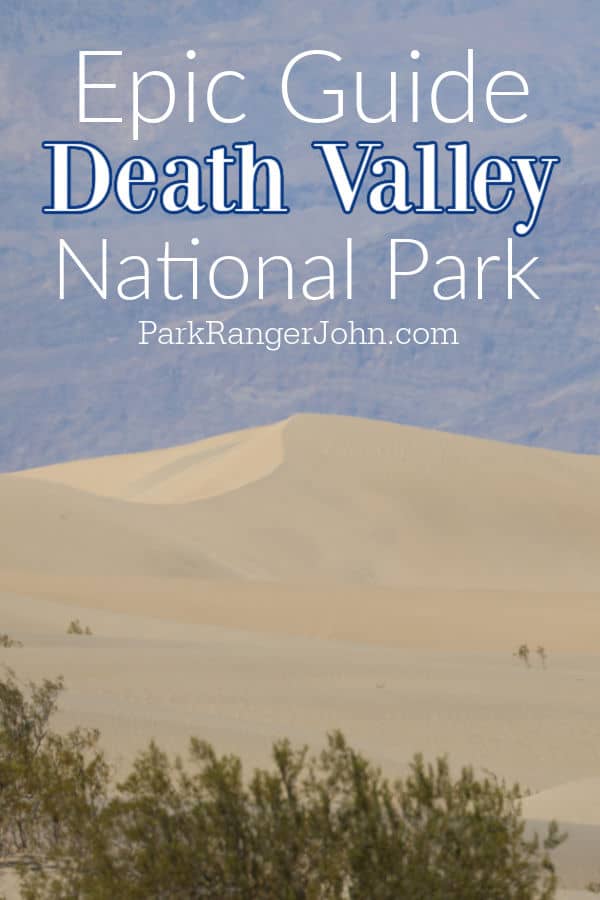
Death Valley National Park
The first thing to know about Death Valley is it is HUGE! The second thing to know about Death Valley is that it is a land of extremes! What does this mean for a park visitor?
Death Valley is the largest National Park in Size in the Contiguous U.S. with 3.4 million acres. In this area, you will find the lowest point in the Northern Hemisphere at Badwater Basin at 282 feet below sea level. Then you will find Telescope Peak, the park's tallest peak a short 16 miles away that reaches a whopping 11,048 feet in elevation!
It is the driest part of North America. It is so dry that in the years 1929 and 1953 the park experienced no measurable precipitation!
Furnace Creek is famous for setting the world's record for the hottest air temperature at 134 degrees Fahrenheit on July 10, 1913.
In 2001, there were 154 consecutive days in a row where the temperature was above 100 degrees Fahrenheit!
The golf course sitting at the lowest elevation in the world is the Furnace Creek Golf Course at 214 feet below sea level.
It is often windy in the desert, especially in the spring.
The Daytime High is on average 28 degrees warmer than the average low temperature so make sure to wear layers.
You should arrive as early in the morning as you possibly can and give yourself more than enough time to explore. Make sure to plan a hike earlier in the morning before the temperature rises.
If you are coming in from Vegas for the day, have a plan of what you want to see and what is within reach during the time you have available.
Parts of the park including the rolling rock area also known as the Racetrack Playa take a couple of days to visit. It also requires you to be self-sufficient, have a solid 4 wheel drive vehicle, have at minimum one spare tire, and always use the buddy system when exploring remote areas. I talked to a visitor who had just got back from the Racetrack and they went with two Jeep Wranglers. They stated that the road is rough and they replaced 3 tires between them. They also stated it was a place to have some 4 wheel drive experience before going.
Make sure and bring plenty of water with you. Depending on the time of year you are visiting the park, the temperatures can get dangerously hot. During one of our visits a tourist, unfortunately, passed away on the dunes due to the heat.
Carry extra water, snacks, sun protection with you. Many areas of the park are very remote and something as simple as a vehicle breakdown can suddenly become a life-threatening emergency for those who do not come prepared.

About Death Valley National Park
It occupies an area of 3,340,370, including the Saline Valley, almost the entire Valley of Death, an important part of the Panamint Valley as well as diverse mountain ranges.
The park has several mountain ranges including the Owlshead Mountains, Black Mountains, Greenwater Range, Panamint Range, Amargosa Range, Nelson Range, Saline Range, and the Last Chance Range.
It is a park located in an arid zone and contains one of the largest desert reliefs in the continental United States.
The lowest point of Death Valley, known as Badwater, is located 282 feet below sea level, while Mount Whitney(the highest peak in the contiguous U.S.), located about 130 miles by road and just over half in a straight line, has a height of more than 14,400 feet above sea level.
The heart of the park, called Death Valley National Monument, was created in 1933. It was promoted to the category of National Park in 1994, the date on which it was extended considerably.
In addition to the central part of the park, a small area known as the Devil's Hole is located in eastern Nevada, near the Ash Meadows National Wildlife Refuge.
The park is formed by two main valleys: Death Valley and Panamint, both formed millions of years. It is separated from the Pacific Ocean by five mountain ranges that completely dry the oceanic air that carry moisture.
The soil of the Death Valley National Park is rich in various minerals, such as borax, which was exploited for a long time by a mining company that used it in the manufacturing of soaps. The refined final product was transported through the valley by large carts pulled by groups of 18 mules and two horses that gave the name of the brand of soap - 20 Mule Team.
Bighorn sheep live in the park and its surroundings which is a rare species found in small isolated herds in the Sierra and in Death Valley National Park. These animals are very adaptable and can eat almost any plant; they do not have known predators and their greatest danger is losing their natural habitat.
The first tourist facilities documented in the Death Valley National Park were a group of stores built in the 1920s. People began to go to the facilities built near natural sources as they considered that they possessed healing properties.
In 1927, one of the borax operating companies converted the Furnace Creek Ranch, which until then served as the team's headquarters, into a tourist resort. The water source that was Furnace Creek was channeled to allow the development of the resort which caused the surrounding lands and swamps to start drying up.
Very soon the valley became a very popular destination and more facilities were built.
Although the lack of water is a general feature throughout the park, you can see different natural environments inside.
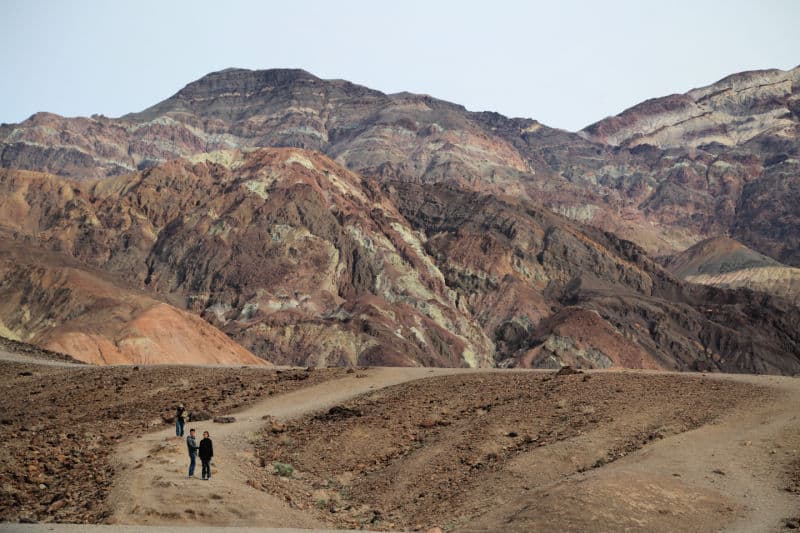
Is Death Valley National Park worth visiting?
Yes! I personally love Death Valley and it has become one of my favorite winter parks to visit, especially when I am starting to suffer from a lack of vitamin D in the winter.
Death Valley is so easy to access as so many cities have direct flights to Las Vegas, then a short two-hour drive to the park. The weather in the winter is so pleasant that it just makes me want to lace up my boots and go hit the trails and explore. It's the perfect blend of not too hot and not too cold especially when I generally leave snow-covered eastern Washington.
History of Death Valley National Park
The Timbisha Shoshone Indians lived in this valley for centuries before any presence of white man. They found food by hunting and gathering pinyon pine nuts. The land provided what they needed to survive and many places here are considered sacred to them.
The 49ers were amongst the first white people to show up with hopes of finding gold. Death Valley appeared to be a shortcut for the exhausted travelers and most turned around before getting to Death Valley.
Shortly after the 49ers, a group of Chinese workers built Panamint City in the 1870'swho started a successful mining operation called Harmony Borax Works that operated from 1883 to 1888.
No history lesson of Death Valley would be complete without talking about Walter Scott, AKA Death Valley Scotty. He worked several jobs around Death Valley in his youth including the Harmony Borax Works. He grew up on a horse farm in Kentucky and was an accomplished horseman which landed him a job as a roughrider for the Buffalo Bill Wild West Show. He spent 12 years with the show before a disagreement when he decided to leave the show.
He then convinced several investors to invest in a gold mining operation that produced no results. Eventually, all of his investors backed out except for one who demanded he take him to the mine. His Name was Albert Mussey Johnson.
Scotty thought he would run the city slicker around in the brutal desert heat of Death Valley for a couple of days and he would give up.
On the contrary, Johnson actually started feeling much better and his health conditions approved and they both rode around the desert for a month and became great friends.
Johnson ended up buying property in the Grapevine Canyon and built Scottys Castle, a summer retreat for him and his wife. Of course, Scotty was allowed to live there until the day he passed away.
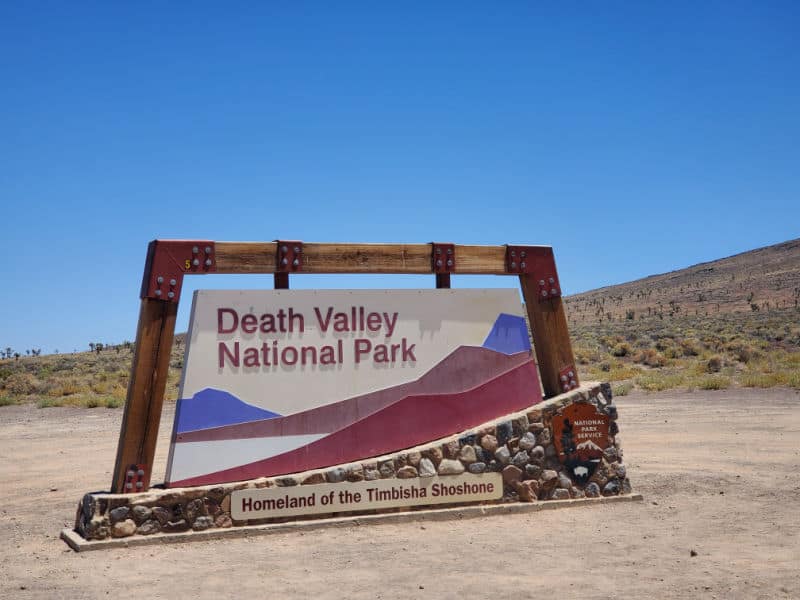
Things to know before your visit to Death Valley National Park
Death Valley National Park Entrance Fee
Park entrance fees are separate from camping and lodging fees.
Park Entrance Pass - $30.00 Per private vehicle (valid for 1-7 days from the date of purchase)
Park Entrance Pass - Motorcycle - $25.00 Per motorcycle (valid for 1-7 days from the date of purchase)
Per-Person Entrance Pass - $15.00 Visitors 16 years or older who enter on foot, bicycle, or as part of an organized group not involved in a commercial tour.
Annual Park Entrance Pass - $55.00, Admits pass holder and all passengers in a non-commercial vehicle. Valid for one year from the month of purchase.
$0.00 for Education/Academic Group
$35.00-$75.00 for vehicles with 1-6 seats commercial sedan, $25 per vehicle plus $10.00 per person
$75.00 for commercial van with 7-15 seats
$100.00 for commercial van with 16-25 seats
$200.00 for commercial motorcoach with 26+ seats
$15.00 per person for non-commercial group (16+ persons) ex. scout groups, church groups, etc.
Learn more about National Park Passes for parks that have an entrance fee.
$80.00 - For the America the Beautiful/National Park Pass. The pass covers entrance fees to all US National Park Sites and over 2,000 Federal Recreation Fee Sites for an entire year and covers everyone in the car for per-vehicle sites and up to 4 adults for per-person sites.

Buy your pass at this link, and REI will donate 10% of pass proceeds to the National Forest Foundation, National Park Foundation, and the U.S. Endowment for Forestry & Communities.
National Park Free Entrance Days -Mark your calendars with the five free entrance days the National Park Service offers annually.
Time Zone
PST - Pacific Standard Time
Pets
Pets must be restrained on a leash no longer than 6 feet.
Pets are not permitted on trails (this includes the boardwalks at Badwater and Salt Creek and paved trails such as Zabriskie Point and Harmony Borax Works) or in Wilderness.
Pets may not enter park buildings including visitor centers and historic structures and are not permitted on Ranger-led tours.
Cell Service
Cell phone access within the park is limited. Visitors with certain major carriers find service (though slow and limited) can be found in Furnace Creek and Stovepipe Wells.
Park Hours
The park is open daily all year.
Wi-Fi
WiFi is not available at any NPS facility.
WiFi can be purchased at the private resort, The Oasis at Death Valley, in Furnace Creek.
Limited free WiFi is available at the Death Valley Lodging Company in Stovepipe Wells.
Food/Restaurants
The Inn at Death Valley Dining Room
-
- Breakfast 7:00 a.m. – 10:00 a.m.
- Dinner 5:00 p.m. – 9:00 p.m.; Dinner Reservations are Recommended
The Ranch at Death Valley
- The Ranch 1849 Buffet
- Breakfast 6:30 a.m. - 10:00 a.m.
- Lunch 11:00 a.m. - 2:00 p.m.
- Dinner 4:00 p.m. - 9:00 p.m.
- The Last Kind Words Saloon
- Breakfast 6:30 a.m. - 10:00 a.m.
- Lunch 11:00 a.m. - 2:00 p.m.
- Dinner 4:00 p.m. - 9:00 p.m.
- Bar Bites 2:00 p.m. - 4:00 p.m.
- Coffee and Cream
- 10:00 a.m.-4:00 p.m.
- General Store
- 8:00 a.m. - 8:00 p.m.
- Golf Pro Shop
- 6:00 a.m. - 12:00 p.m. (Thursday-Sunday)
Timbisha Shoshone Village
- Indian Tacos and Shaved Ice: A small lunch and early dinner dining option in the Furnace Creek area.
- Furnace Creek Visitor Center/Death Valley Natural History Association Bookstore: Grab and go sandwiches and drinks
- 8:00 a.m. - 5:00 p.m.
Stovepipe Wells Village
- Toll Road Restaurant: Breakfast, lunch and dinner served in a casual setting.(Currently Closed)
- Breakfast: 7:00 a.m. - 10:00 a.m.
- Dinner: 5:30 p.m. - 9:00 p.m.
- Badwater Saloon:
- Breakfast: 7:00 a.m. - 10:00 a.m.
- Lunch/Dinner 11:00 a.m. - 8:00 p.m.
- General Store: ATM, groceries, ice, camping supplies, gifts, and firewood.
- 7:00 a.m. - 10:00 p.m. daily
Panamint Springs Resort
- Dining & Bar: Breakfast, lunch and dinner served year-round. Patio seating available.
- General Store: ATM, snacks, firewood, camping supplies, and gifts
- 7:00 a.m. - 9:00 p.m.
Gas
There are a couple of gas stations located within the park. You will want to be prepared for the gas prices to be higher than you may expect them to be.
Don't forget to pack
Insect repellent is always a great idea outdoors, especially around any body of water.
We use Permethrin Spray on our clothes before our park trips. Please read my article on preventing biting insects while enjoying the outdoors.
Sunscreen - I buy environmentally friendly sunscreen whenever possible because you inevitably pull it out at the beach.
Bring your water bottle and plenty of water with you. Plastic water bottles are not sold in the park.
Sunglasses - I always bring sunglasses with me. I personally love Goodr sunglasses because they are lightweight, durable, and have awesome National Park Designs from several National Parks like Joshua Tree, Yellowstone, Hawaii Volcanoes, Acadia, Denali, and more!
Click here to get your National Parks Edition of Goodr Sunglasses!
Binoculars/Spotting Scope - These will help spot birds and wildlife and make them easier to identify. We tend to see waterfowl in the distance, and they are always just a bit too far to identify them without binoculars.
Electric Vehicle Charging
Six electric vehicle (EV) charging stations have been installed at The Oasis at Death Valley to serve visitors to Death Valley National Park.
Currently, the charging stations are free and powered by The Oasis at Death Valley’s onsite solar field. Four chargers are located at The Ranch at Death Valley and two at the Inn at Death Valley.
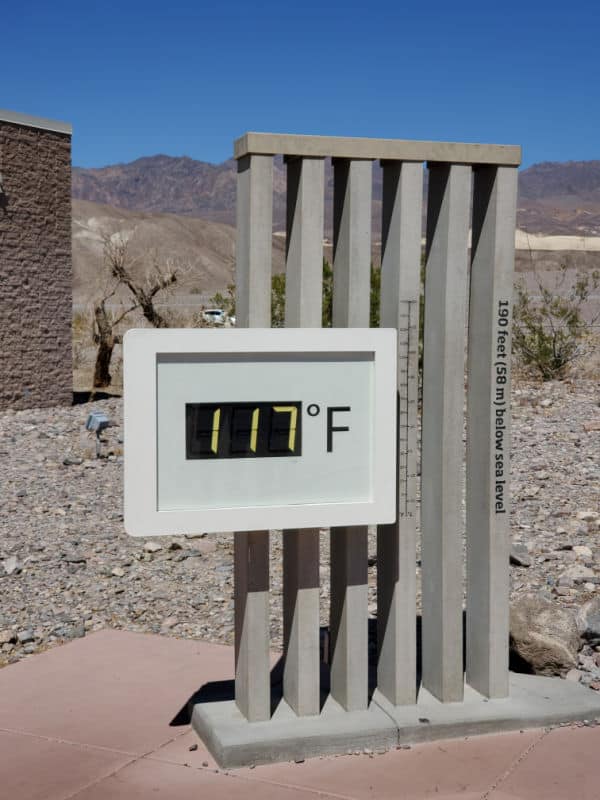
Details about Death Valley National Park
Size - 3,422,024 Acres
Death Valley NP is currently ranked at 5 out of 63 National Parks by Size.
Death Valley is the largest U.S. National Park outside Alaska at 3,422,024 acres.
93% of the park is protected as officially designated Wilderness.
Date Established
Death Valley was designated a national monument in 1933 and made a national park on October 24, 1994.
Visitation
In 2021, Death Valley NP had 1,146,551 park visitors.
In 2020, Death Valley NP had 820,023 park visitors.
In 2019, Death Valley NP had 1,740,945 park visitors.
Learn more about the most visited and least visited National Parks in the US
National Park Address
There is no specific street address for the park or the Furnace Creek Visitor Center.
Map coordinates for the visitor center are:
N 36°27.70
W 116°52.00
Many GPS users have had success using the street address for the Death Valley Post Office which is located about 400 meters south of the visitor center.
The post office address is:
328 Greenland Blvd.
Death Valley, CA 92328
Death Valley National Park Map
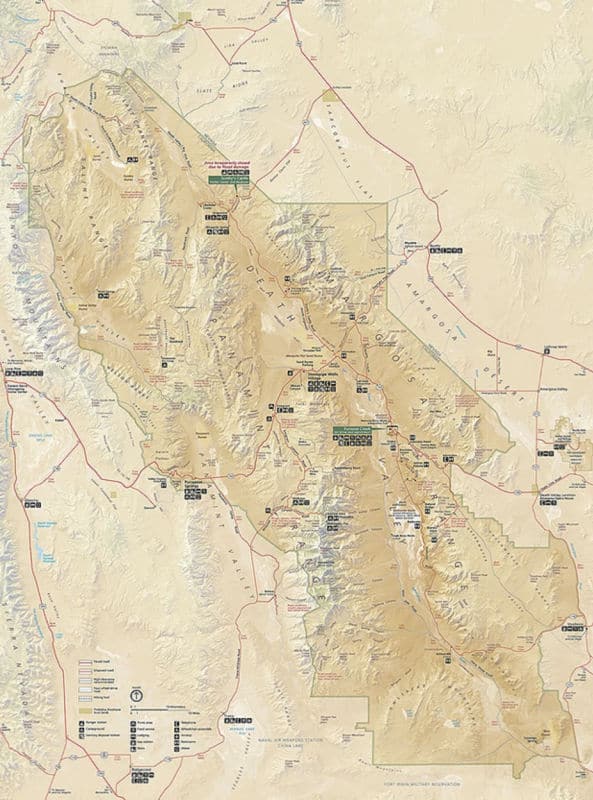
Where is Death Valley National Park?
Death Valley National Park is a national park in the United States located east of Sierra Nevada, in the state of California, but also extends (to a small extent) in the state of Nevada.
Estimated distance from major cities nearby
Las Vegas, Nevada : 89 miles, 1 hour and 40 minutes
Los Angeles, California: 276 miles, 4 hours and 40 minutes
San Francisco, California: 561 miles, 8 hours, and 50 minutes
San Diego, California: 324 miles, 5 hours and 25 minutes
Salt Lake City, Utah: 526 Miles, 7 hours and 20 minutes
Phoenix, Arizona: 387 miles, 6 hours and 21 minutes
Estimated Distance from nearby National Park
Joshua Tree National Park: 240 Miles, 3 hours and 55 minutes
Zion National Park: 261 miles, 4 hours and 5 minutes
Channel Islands National Park: 320 miles, 7 hours and 2 minutes
Grand Canyon National Park: 361 miles, 5 hours and 51 minutes
Bryce Canyon National Park: 362 miles, 5 hours and 25 minutes
Sequoia National Park: 371 miles, 6 hours and 8 minutes
Great Basin National Park: 394 miles, 6 hours and 15 minutes
Kings Canyon National Park: 440 miles, 8 hours and 27 minutes
Arches National Park: 555 miles, 7 hours and 45 minutes
Where is the National Park Visitor Center?
Furnace Creek Visitor Center
Furnace Creek Visitor Center offers park information, Wi-Fi, exhibits, a park film, bookstore, ranger information, drinking water, and restrooms. This is a great place to start your trip in Death Valley.
Phone(760) 786-3200
Location - The visitor center is located in the Furnace Creek resort area on California Highway 190. Furnace Creek is 30 miles from Death Valley Junction and 24 miles from Stovepipe Wells Village.
Scotty's Castle Visitor Center
Currently closed due to flooding.
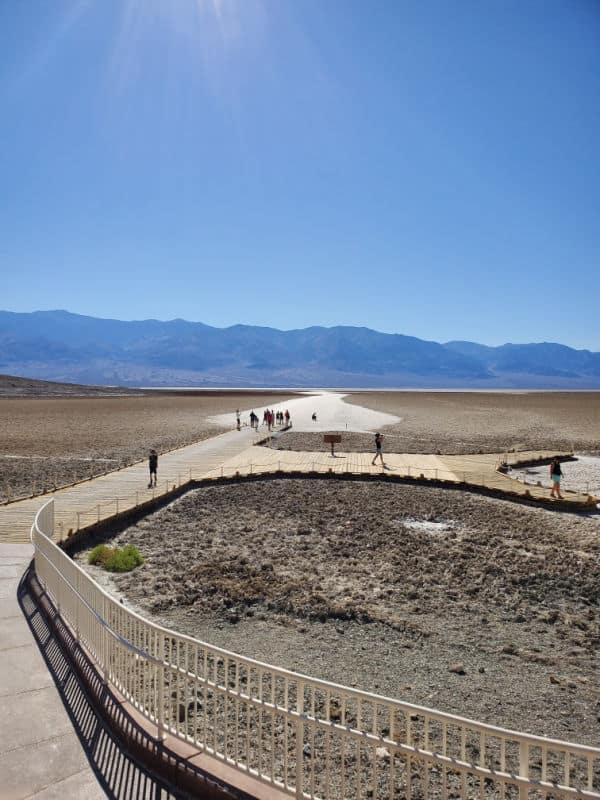
Getting to Death Valley National Park
There is no public transportation available to Death Valley National Park.
Closest Airports
There are no scheduled commercial flights to airports within Death Valley National Park. Pilots with their own aircraft may use the airports, but other than a shuttle service provided for guests of the Furnace Creek Inn & Ranch Resorts, there is no public ground transportation or rental vehicles available from either airport.
Furnace Creek Airport - L06
This airport is located 1 mile NW of Furnace Creek Ranch within the park. It is only available for pilots with their own aircraft.
Stovepipe Wells Airport -L09
This airport is located .25 miles west of Stovepipe Wells Village within the park.
There is NO aircraft fuel available at either airport.
International Airports
McCarren International Airport - Las Vegas (LAS): 89 miles, 1 hour and 40 minutes
Fresno Yosemite International Airport (FAT): 367 miles, 6 hours and 25 minutes
Palm Springs International Airport (PSP): 257 miles, 4 hours and 30 minutes
Los Angeles International Airport (LAX): 276 miles, 5 hours and 45 minutes
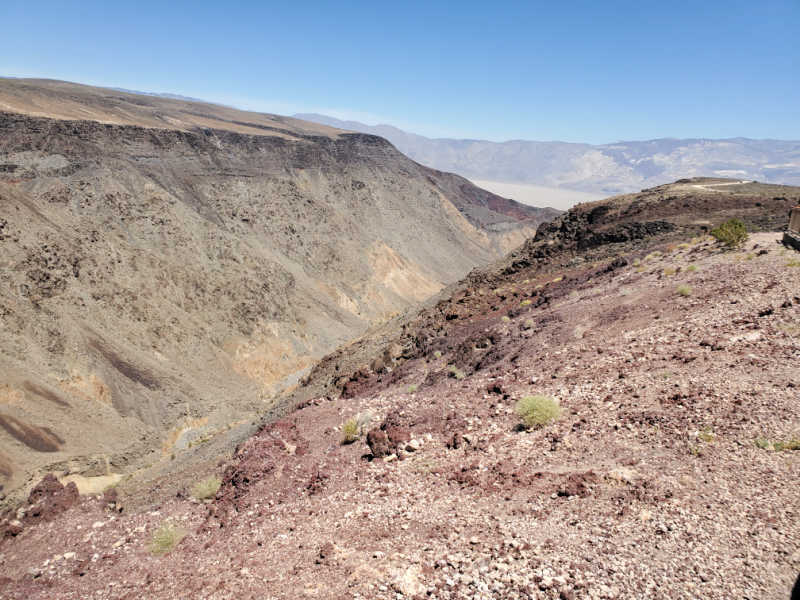
Driving Directions
The main road transecting Death Valley National Park from east to west is California Highway 190.
On the east in Nevada, U.S. Route 95 parallels the park from north to south with connecting highways at Scotty's Junction (State Route 267- Access closed until further notice), Beatty (State Route 374), and Lathrop Wells (State Route 373).
The most direct route from Las Vegas is via Pahrump, NV, and California Highway 190.
Coming from the west, State Route 14 and U.S. Route 395 lead to Ridgecrest, CA where State Route 178 heads east into the park. Further north on Hwy 395 at Olancha, CA you can join Hwy 190 to the park, or north of that at Lone Pine, CA, Hwy 136 will also join Hwy 190 heading east into the park.
South of the park, Interstate 15 passes through Baker, California on its way from Los Angeles to Las Vegas. State Route 127 travels north from Baker to Shoshone and Death Valley Junction with connections to the park on State Route 178 from Shoshone and connection with California Highway 190 at Death Valley Junction.
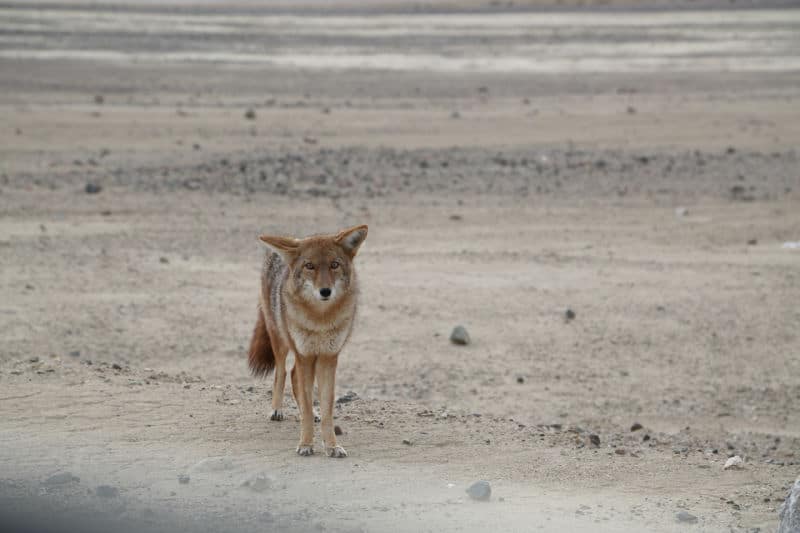
Best time to visit Death Valley National Park.
Depending upon your personal interests, Death Valley can be a great park to visit any time of the year. Visiting the main part of the park is most enjoyable in the winter. Others may want to show up in the spring after a major rainfall and see the wildflowers. If you want to hike to the highest peaks then summer is the best time to visit.
Death Valley National Park Weather and Seasons
Death Valley has dramatic differences depending upon the time of year you visit. January's average High is 67 degrees while the average low os 40 degrees.
Compare this to July where the average high temperature is 116 degrees and the average low is 88 degrees. Spring and fall average highs are in the upper 80's to low 90's and average lows are in the 60's and 70's.
Spring
The spring is a great time to visit Death Valley. it is often windy in the desert but this is especially true in the spring. Be prepared for dust storms as they can blow up with approaching cold fronts.
Death Valley is famous for the big attraction that happens in the spring, it's the wildflower bloom. About once every 10 years a massive super bloom takes place where wildflowers carpet the floor of the park with a sea of gold, purple, pink and white flowers. The most recent super blooms happened in 2016, 2005, and 1998.
Not every year has a major bloom, some are average but there is never a year where they are completely absent of wildflowers.
Spring is the best time to visit the Salt Creek Interpretative Trail. Between February and April is your chance to see the Salt Creek Pupfish in spawning season. These little pupfish can only be found in Death Valley National Park!
Summer
The main portion of the park is extremely hot during the summer making it almost unbearable to enjoy during the heat of the day. However there is plenty to do if you decide to go up and explore the high mountainous country of the park that is often inaccessible during the winter.
This is a great time to hike Telescope Peak. This is a 14 mile out and back hike with a 3000 foot elevation gain. It is considered a strenuous hike and will have moderate traffic. You will get to see Bristlecone Pines and the real payoff is at the summit where on a clear day you can see Mount Whitney and Badwater basin at the same point!
On summer afternoons, little moves in the Valley as the temperature inches steadily higher. Yet a remarkable array of living things has come to terms with the desert.
Fleshy green pickleweed crowds the margins of Salt Creek and Badwater, growing in a medium so salty it would kill most other plants. Creosote bushes lard their tissues with a resinous sap that reduces evaporation and discourages nibbling by animals, while cacti store their meager ration of water inside their swollen spiny stems.
In fact, thorns, bristles, and hairs are common on desert plants, both to ward off animals and to protect the leaves from the drying effects of wind and sun.
Other kinds of desert plants survive by cramming their lifetimes into a few short weeks. Waiting in the rocky, seemingly desolate soil are millions of seeds, shielded from the elements by tough, protective shells, biding their time, sometimes for years, for exactly the right combination of mild temperatures and sudden moisture.
When Death Valley's hit-or-miss winter rains arrive, the seeds break their long dormancy and explode into growth, carpeting the desert with flowers in a kaleidoscope of colors.
In contrast to the arid lowlands, the mountains that rim Death Valley are much cooler and wetter, and so they harbor an even greater diversity of life.
Starting at about 4,000 feet above sea level, the creosote bushes, mesquite, and desert hollies give way to sage, juniper, and pinyon pine; at about 8,500 feet, forests of mountain mahogany and juniper take over, sheltering mule deer and the mountain lions that hunt them.
Higher still stand cold-tolerant bristle-cone pines, some of them thousands of years old, their branches sheared and contorted by the wind.
Of Death Valley's natural inhabitants, perhaps none is more surprising than its fish, or as dependent on tiny, fragile bits of habitat.
The endangered Devil's Hole pupfish, electric blue and barely an inch long, for instance, has the smallest natural range of any vertebrate in the world. The entire population, which numbers just a few hundred, is restricted to a shallow rock shelf along one side of Devil's Hole, a deep cavern flooded with 92 °F water.
Autumn/Fall
Fall arrives in late October at Death Valley. You will be greeted with warm temperatures and typically clear blue skies. This is a refreshing contrast from the blistering summer heat!
This is also the beginning of the busy season for Death valley as the campgrounds begin to open and ranger programs start back up.
Winter
Winter is my favorite time to visit Death Valley. The temperatures are perfect for a hike in the valley and visiting many of the park's best things to do and see.
The peak winter visitation periods include Christmas to New Year's, Martin Luther King Day weekend in January, and Presidents' Day weekend in February. It is highly recommended to have reservations for camping and lodging.
This is also the perfect time to explore one of the many sand dunes in the area including Mesquite Flat, Ibex Dunes, Panamint Dunes, and Eureka Dunes.
Best Things to do in Death Valley National Park
There are so many epic things to see and do while visiting Death Valley.
Artists Drive
Artist's Drive is a must-visit during any trip to Death Valley! We highly suggest visiting the drive a few times to see how the rocks look different depending on where the sun is.
The drive is a 9-mile paved route that includes multiple pull-offs for great photos. The road is one-way and open to vehicles less than 25 feet in length.
Artist's Palette is located on the slope of the Black Mountains and stands out for the diversity of color of the rock formations.
This variation of colors comes from the oxidation of metals: red and yellow come from iron; the green comes from the decomposition of the mica, and the purple from the oxidation of manganese.
Harmony Borax Works
Harmony Borax Works is a quarter-mile walking trail that has educational signs teaching about the Harmony Borax operation.
This is the area famous for the twenty mule teams that moved borax from Death Valley.
Charcoal Kilns
Charcoal Kilns were built in 1867 to transform pine nuts into charcoal that were later used as fuel in the valley mines. They were restored in 1971 by a group of Navajos.
Dante's View
Dante's View offers a special panoramic view of the central area of the park thanks to its height, about 5,570 feet above sea level.
Devil's Golf Course
Devil's Golf Course is an area of salt flats in which a series of holes have been formed that give the place a strange and ghostly appearance.
Mesquite Flat Sand Dunes
The sand dunes are located north of the valley at the Stovepipe Wells intersection. Thanks to the ease of access by road, the dunes have appeared in various Hollywood productions, including the Star Wars series.
Racetrack Playa
Racetrack Playa is a dry lake bed famous for its sailing stones, large rocks that move by the action of natural forces, without human or animal intervention. Although they move up to 5 miles per hour ( fast, considering they are rocks) no one has seen their movement in person.
Zabriskie Point
Zabriskie Point offers a view of multicolored geological formations. It was one of the areas where borax exploitations were carried out. The director of cinema Michelangelo Antonioni made in 1970 a film with this same name.
Check out all of the amazing things to do in Death Valley!
Ubehebe Crater
Ubehebe Crater is a large basket-like volcanic crater that is 600 feet deep and half a mile across located in the northern portion of the park.
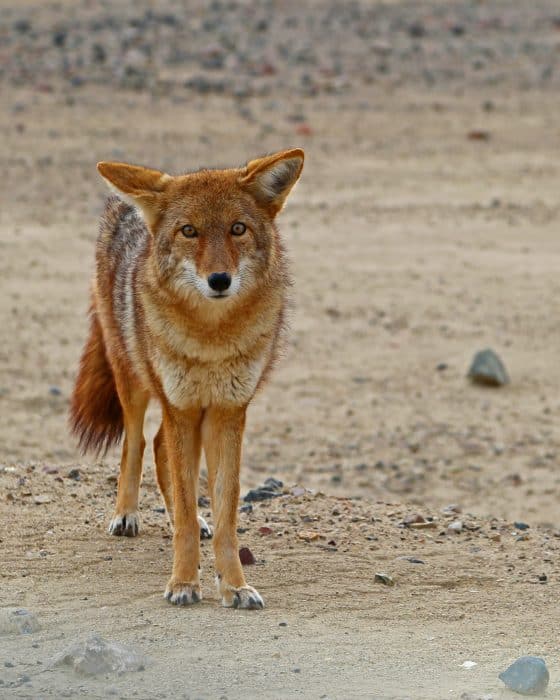
Wildlife Viewing
The vegetation is varied, staggered, and adapted to dryness: shrubs, such as Larrea tridentata or Prosopis glandulosa in the valley; in the high areas there are pine trees and Yucca brevifolia also known as Joshua trees. There are about 1,000 different plant species, of which 23 are endemic.
The fauna is also diverse: you can find 51 native species of mammals, 307 species of birds, 36 species of reptiles, 3 of amphibians, and 2 species of fish (in the area of Salt Creek and Cottonwood Marsh).
Although small mammals are more frequent, coyotes, foxes, lynxes, cougars, and mule deer can also be found in the park.
International Dark Sky Park
Death Valley is an International Dark Sky Park. If you have the opportunity try and stay overnight in the park so you can experience the stars unlike anywhere else in the world.
Furnace Creek Golf Course
Furnace Creek Golf Course is located 214 feet below sea level. This is also a great area for bird watching.
Junior Ranger Program
Junior Ranger Programs can be picked up at the visitor center. They are a fantastic way for all ages to learn more about this great park.
Guided Tours
From Las Vegas - Private SUV Tour of the Park
Adventure to Death Valley referred to as “Mars on Earth" for a full-day private tour from Las Vegas. Marvel at the oft-overlooked diversity of this park. Explore the Badwater Basin which contains the lowest point in North America as well as Telescope Peak. From peaks to salt flats to amazing colors, Death Valley has many facets.
From Las Vegas - Death Valley Day Tour
Enjoy the scenic outdoors and rugged extremes of the western United States with a visit to Death Valley. Sample local treats and visit top secret Area 51. See ghost towns of the Wild West, and famous Zabriskie Point.
From Las Vegas - Death Valley Trekker Tour
Explore the beauty of the Death Valley NP on this day trip from Las Vegas. Ride in a comfortable, all-terrain vehicle to the park's unique hotspots like Badwater and Zabriskie Point. Savor a mouth-watering dinner or lunch on your adventure.
From Las Vegas - Full Day Group Tour
Start your day early as you travel from your hotel in Las Vegas to the Mesquite Flat Sand Dunes. Walk in the dunes and snap some beautiful photos. Head towards the Badwater Basin Salt Flats, which is famous for being the lowest point in North America.
From Las Vegas - Small Group tour
Spend the day touring one of the most extreme desert environments at Death Valley NP on a full-day tour that lets you escape the hectic streets of Las Vegas. Purchase 5 seats and enjoy a fully private tour.
From Las Vegas - Day trip with stargazing and wine tour
Take in the highlights of Death Valley's desert landscape on an all-day guided hike with free hotel pickup from Las Vegas. Taste wine during a tour of a local winery and stop to take in incredible views of the sunset and the starlit sky.

Hiking in Death Valley National Park
There are several trails varying from easy to difficult in Death Valley. No matter the rating, the weather can make any of these hikes dangerous for the ill-prepared.
The summer heat already puts our bodies in labor dealing with the intense heat. Combine that with hiking on sand that is soft that makes us labor even harder to complete the hike and this can be a recipe for heat exhaustion, heatstroke or worse, a heart attack.
Throughout my career, I have responded to numerous medical emergencies that turned out to be a heart attack from someone laboring too hard in the summer months, especially for those of us getting a little older, and don't listen to our bodies, and not being 20 anymore.
Always carry the 10 essentials for outdoor survival when exploring.
Here are a few easy trails not to miss on your first visit to Death Valley.
Salt Creek Interpretive Trail
Salt Creek Interpretive Trail is a great walk for the entire family. The entire trail has a boardwalk. The trail is a ½ mile round trip.
One thing to know is most of it is out in the open so bring water and a hat or sunglasses along with sunscreen. Keep an eye out for rare pupfish and other wildlife along the trail.
Badwater Salt Flat
This is a unique hike as it is a short one-mile out and back stroll along the lowest part of the Northern Hemisphere.
That's right, you are hiking at 282 feet below sea level! Make sure to notice the sign in the wall on your way back to the trailhead showing you where sea level is. This sure puts it into perspective.
Mesquite Flat Sand Dunes
This is a 2 mile out and back hike on the sand dunes. Make sure to hike within your limits and enjoy this unique area of the park.
Also try to show up early after a windy night to see the dunes free of all the foot tracks!
How to beat the crowds in Death Valley?
The period after Thanksgiving and before Christmas is the least crowded time of the entire year. Incidentally, this is also a beautiful time in the park and the perfect time to beat the crowds in Death Valley!
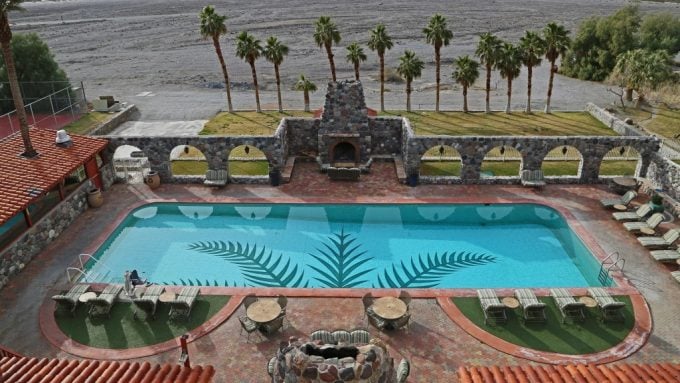
Death Valley National Park Lodging
There are four National Park Lodges available within the park.
Stovepipe Wells Village
Location - Stovepipe Wells
Season - Year-round
The Inn at Death Valley
Location - Furnace Creek
Available to book on Expedia
The Ranch at Death Valley
Location - Furnace Creek
Season - Year round
Available to book on Expedia
Panamint Springs Resort
Location - Panamint Springs
Season - Year Round
Available to book on Expedia
Lodging near Death Valley
Lodging near the park can be found in Beatty, Pahrump, and Las Vegas, Nevada.
There is also lodging available in Shoshone, Lone Pine, Ridgecrest, and Bishop, California
Longstreet Inn - 3-star hotel by the lake. Enjoy American cuisine, garden views, and al fresco dining at the two onsite restaurants. Free in-room Wi-Fi is available to all guests, along with designer stores on site and a coffee shop/café.
Pahrump Nugget Hotel - All guestrooms at Pahrump Nugget Hotel and Casino boast thoughtful touches such as air conditioning, as well as amenities like free Wi-Fi and free bottled water.
Holiday Inn Express & Suites Pahrump - free continental breakfast, golfing on site, and a terrace. For some rest and relaxation, visit the hot tub. Enjoy the 24-hour gym, as well as activities like tennis. Free in-room Wi-Fi is available to all guests, along with laundry facilities and a bar.
Best Western Pahrump Oasis - free continental breakfast, a bar, and a 24-hour business center. For some rest and relaxation, visit the 2 hot tubs. Free Wi-Fi in public areas and a restaurant are available to all guests.
Click on the map below to see additional vacation rental and lodging options near the park.

Death Valley National Park Camping
The number of campgrounds open in the park depends on the season you are visiting.
There are only a few campgrounds open during the summer months due to the extreme temperatures.
Furnace Creek Campground
Location - Furnace Creek
Season - Year-round
Campsites - 136, 18 hook up sites
Reservations - Yes from October 15 to April 15th, no reservations the rest of the year.
Reservations for the Furnace Creek Campground are available for the camping season of October 15 to April 15 by calling 1-877-444-6777 or visiting recreation.gov.
Reservations must be made at least 2 days in advance, but can be made up to 6 months in advance.
RV hookups - Furnace Creek Campground has only 18 sites with full hookups and is often booked 6 months in advance. These are 30/50 amp hookups (both types at each site) and water/sewer hookups.
Sunset at Furnace Creek
Location - Furnace Creek
Season - Open late fall through spring
Campsites - 270
Reservations - No reservations
Texas Springs at Furnace Creek
Location - Furnace Creek
Season - Open late fall through spring
Campsites - 92
Reservations - No reservations
Stovepipe Wells
Location - 30 minutes from Furnace Creek
Season - Open late fall through spring
Campsites - 190
Reservations - No reservations
Mesquite Springs
Location - 1 hour 15 minutes from Furnace Creek
Season - Open year-round
Campsites - 30
Reservations - No reservations
Emigrant - Tent Only
Location - 40 minutes Furnace Creek
Season - Open year-round
Campsites - 10
Reservations - No reservations
Wildrose
Location - 1 hour 15 minutes from Furnace Creek
Season - Open year-round
Campsites - 23
Reservations - No reservations
Thorndike
Location - 1 hour 30 minutes from Furnace Creek
Season - Open late spring through fall
Campsites - 6
Reservations - No reservations
Mahogany Flat
Location - 1 hour 45 minutes from Furnace Creek
Season - Open late spring through fall
Campsites - 10
Reservations - No reservations
There are also three privately owned campgrounds within the park. They accept reservations year-round at Stovepipe Wells RV Park, The Ranch at Death Valley, and Panamint Springs Resort
Backcountry Camping
Backcountry camping is allowed at least 1 mile from any paved road or day use only dirt road.
Camping is NOT allowed on the valley floor from Ashford Mill in the south to 2 miles north of Stovepipe Wells, on the Eureka Dunes or in Greenwater Canyon.
Backcountry campsites must be more than 100 yards from any water source to protect these fragile areas for wildlife use.
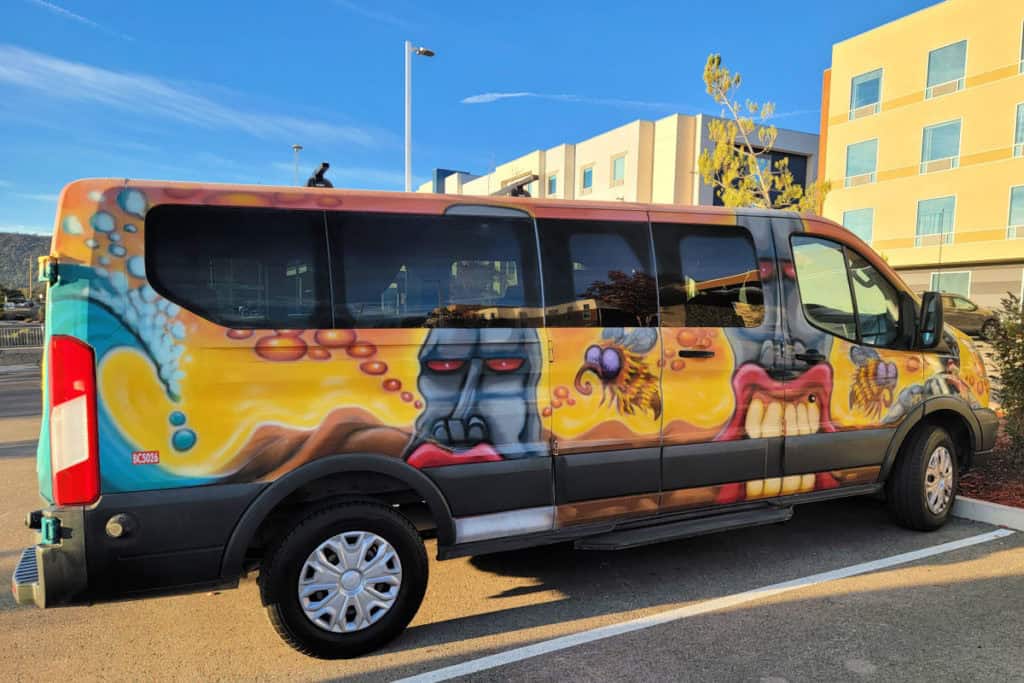
For a fun adventure check out Escape Campervans. These campervans have built in beds, kitchen area with refrigerators, and more. You can have them fully set up with kitchen supplies, bedding, and other fun extras. They are painted with epic designs you can't miss!
Escape Campervans has offices in Vancouver, Seattle, Portland, San Francisco, Las Vegas, Los Angeles, Phoenix, Salt Lake City, Denver, New York, and Orlando
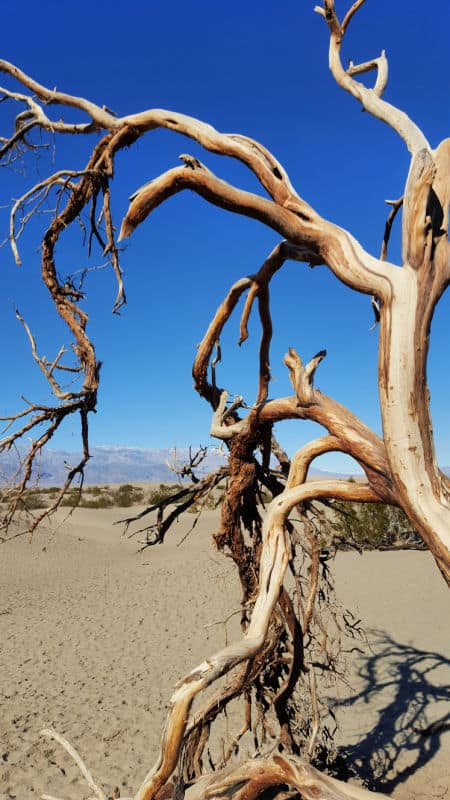
Travel Tips
Scotty's Castle is closed and will remain closed until at least 2023. Please contact 760-786-3200 for more information.
Carry more water and sports drinks with you while hiking than you think you will need.
Pets and Bicycles are not allowed on trails or in the wilderness that covers 90% of the park.
Please do not feed the animals in the park. While we were in the park, we watched a coyote develop a limp as soon as a new car pulled into a parking lot. He limped to the car a few times until they fed him. Once they pulled away the limp was gone, and the coyote ran to another section of the parking lot. He truly worked the tourist over for food.
Don't fall asleep too early and miss seeing the stars. Death Valley is an International Dark Sky Park! The park has worked to reduce light pollution to allow visitors to see the stars.
Give yourself more time than you think you may need to see the park. Many of the attractions are far away from the center of the park. Depending on the time of year you are visiting there may be traffic in the park.
If you are looking for roadrunners keep an eye out by the Furnace Creek Visitor Center. We had one walk up next to the car.
I know this probably won't come as a surprise but gas is expensive in the park.
There are multiple restaurants and a general store in the park. The pizza at the Corkscrew Saloon was ok, not great but definitely filling. They have some interesting-themed cocktails for the park.
If you love to golf make sure and check out the Furnace Creek Golf Course located 214 feet below sea level. This is also a great area for bird watching.
Make sure and visit the visitor center for current park conditions. Parts of the park have been closed due to recent flooding that occurred in the park. The visitor center can let you know exactly which part of the parks is closed or undergoing rehabilitation.
We have found the best times to visit Death Valley are late fall to early spring. The weather is cooler and it is easier to get around.
The Desert Gold is the most common wildflower found on the valley floor.
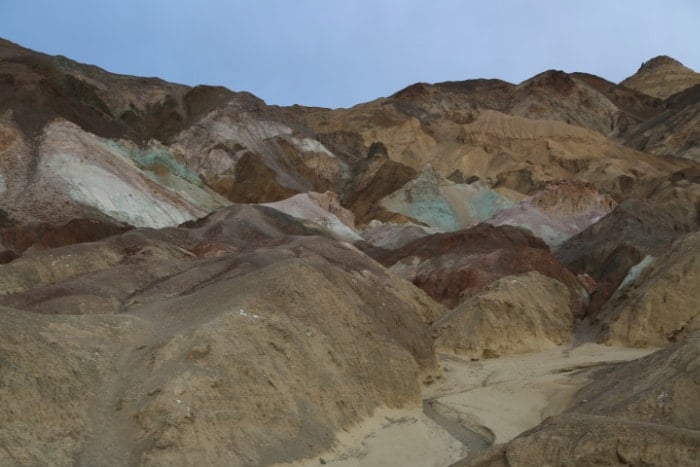
Death Valley National Park Facts
Parks near Death Valley National Park
Tule Springs Fossil Beds National Monument
Lake Mead National Recreation Area
Castle Mountains National Monument
Manzanar National Historic Site
Cesar E Chavez National Memorial
Check out all of the National Parks in California and neighboring Arizona National Parks, Nevada National Parks, and National Parks in Oregon
National Park Service Website

